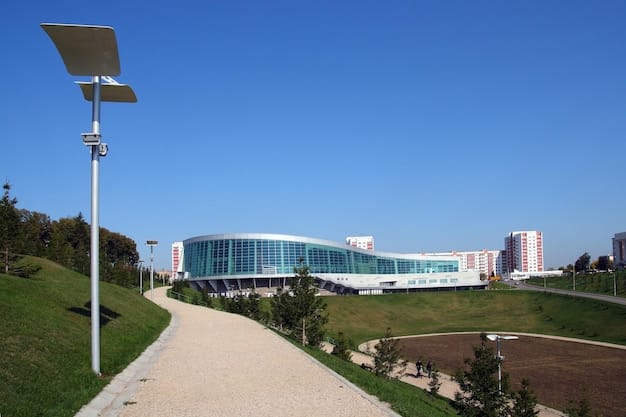Climate Change and Public Health: Preparing for the Next Decade in the US

Climate change significantly impacts public health in the US, creating new challenges related to extreme weather, air and water quality, and infectious diseases. Preparing for these challenges requires comprehensive strategies and collaborative efforts.
The escalating effects of The Impact of Climate Change on Public Health: Preparing for New Challenges in the Next Decade are becoming increasingly apparent, especially within the United States. From extreme weather events to alterations in air and water quality, the health and well-being of communities are directly affected.
Understanding the Direct Health Impacts of Climate Change
Climate change presents a multifaceted threat to public health. Understanding the direct impacts is essential for formulating effective adaptation and mitigation strategies.
Changes in environmental conditions caused by climate change can lead to many health problems that concern our communities in the United States.
Extreme Weather Events and Health
Extreme weather events, such as hurricanes, floods, and heatwaves, are becoming more frequent and intense due to climate change. These events can cause immediate physical injuries, displacement, and mental health issues.
- Heatwaves: Prolonged exposure to high temperatures can lead to heatstroke, dehydration, and cardiovascular stress.
- Floods: Flooding can cause drownings, injuries, and the spread of waterborne diseases.
- Hurricanes: Hurricanes bring high winds, storm surges, and heavy rainfall, causing widespread destruction and health risks.

Addressing these challenges requires robust public health infrastructure, emergency preparedness plans, and resilient healthcare systems. It is important to ensure that communities are equipped to handle the consequences of major weather events.
The Impact of Air Quality on Respiratory Health
Climate change significantly affects air quality, leading to increased respiratory problems. Rising temperatures and altered weather patterns worsen air pollution, directly impacting public health.
This can be especially bad for people with existing conditions and can result in new cases of such issues from poor air quality.
Rising Temperatures and Ozone Levels
Higher temperatures promote the formation of ground-level ozone, a major component of smog. Ozone pollution can irritate the respiratory system, causing coughing, wheezing, and shortness of breath.
- Asthma: Ozone pollution can trigger asthma attacks and worsen symptoms in people with asthma.
- COPD: Exposure to ozone can exacerbate chronic obstructive pulmonary disease (COPD).
- Children’s Health: Children are particularly vulnerable to the effects of ozone pollution due to their developing lungs.
Efforts to improve air quality require reducing emissions from vehicles, industrial facilities, and power plants. This may involve adopting cleaner energy sources like electric vehicles and adhering to stricter environmental regulation.
Water Quality and the Spread of Waterborne Diseases
Changes in precipitation patterns and rising temperatures impact water quality, increasing the risk of waterborne diseases. Ensuring access to clean and safe drinking water is crucial for protecting public health.
When communities are unable to access these items it can cause outbreaks that can overwhelm the local healthcare system.
Contamination and Waterborne Illnesses
Flooding and heavy rainfall can overwhelm water treatment systems, leading to contamination of drinking water sources with pathogens, chemicals, and debris. This can result in outbreaks of waterborne diseases such as giardiasis, cryptosporidiosis, and E. coli infections.
- Giardiasis and Cryptosporidiosis: These parasitic infections cause diarrhea, abdominal cramps, and dehydration.
- E. coli Infections: Contamination of water with E. coli can lead to severe gastrointestinal illness.
Protecting water quality requires investing in robust water treatment infrastructure, monitoring water sources for contamination, and implementing effective sanitation practices. Public education campaigns can also play a role in helping people take actions to protect themselves.
Climate Change and the Spread of Infectious Diseases
Vector-borne diseases, transmitted by insects such as mosquitoes and ticks, expand as the climate becomes more suitable for these insects.
The spread of infectious diseases is influenced by changing temperatures and precipitation patterns, increasing the risk of outbreaks. Understanding these dynamics is essential for effective disease prevention and control.
Changes in Vector Ecology
Warmer temperatures and altered rainfall patterns can extend the geographic range and breeding season of vectors, such as mosquitoes and ticks. This expands the areas where vector-borne diseases can occur.
- Lyme Disease: Ticks carrying the bacteria that cause Lyme disease are spreading to new regions.
- West Nile Virus: Mosquitoes transmitting West Nile virus are becoming more prevalent in many parts of the US.
- Zika Virus: The Zika virus, transmitted by mosquitoes, poses a risk to pregnant women and their babies.
Controlling the spread of infectious diseases requires comprehensive vector control programs, surveillance of disease outbreaks, and development of vaccines and treatments. It is also critical to educate the public about measures to prevent mosquito and tick bites.
Preparing for the Challenges: Adaptation and Mitigation Strategies
To reduce the impacts of climate change on public health, proactive adaptation and mitigation strategies are essential. These strategies aim to protect communities from the health risks associated with a climate shift, and reduce the greenhouse gas emissions that contribute to major climactic changes.
Strategies for both adaptation and mitigation must be implemented to protect vulnerable communities and reduce the overall impacts on our public health.
Building Resilient Healthcare Systems
Strengthening healthcare systems is essential for responding to the health challenges posed by climate change. This includes ensuring that healthcare facilities are resilient to extreme weather events, developing climate-informed disease surveillance systems, and training healthcare professionals to recognize and treat climate-sensitive illnesses.
- Infrastructure Resilience: Hospitals and clinics should be equipped to withstand extreme weather events and maintain operations during emergencies.
- Disease Surveillance: Monitoring disease trends and identifying outbreaks early is critical for effective response.
- Healthcare Training: Training healthcare professionals to address climate-sensitive health issues can improve patient outcomes.

Investing in resilient healthcare systems can help ensure that communities are prepared to handle the public health challenges associated with climate change. It will also improve capacity and reduce the burden on the local health services.
Community Engagement and Public Health Education
Engaging communities and educating the public are critical components of climate change adaptation and mitigation efforts. Empowering individuals to take action can promote awareness of the health risks and encourage sustainable practices.
When people are aware, they are more inclined to take steps that are beneficial for themselves and their communities.
Promoting Awareness and Sustainable Practices
Public health campaigns can raise awareness about the health impacts of climate change and promote sustainable behaviors such as reducing energy consumption, using public transportation, and adopting plant-based diets.
- Energy Conservation: Encouraging energy-efficient practices can reduce greenhouse gas emissions and improve air quality.
- Sustainable Transportation: Promoting the use of public transportation, cycling, and walking can reduce vehicle emissions.
- Plant-Based Diets: Reducing meat consumption can lower the carbon footprint associated with food production.
By empowering individuals and communities to take action, we can create a more sustainable and resilient future for all. The more a focus is placed on public awareness and education, the more public health outcomes that can be achieved.
| Key Point | Brief Description |
|---|---|
| 🔥 Extreme Weather | Increased frequency of heatwaves, floods, and hurricanes impacts physical and mental health. |
| 🌬️ Air Quality | Rising temperatures worsen air pollution, leading to increased respiratory problems. |
| 💧 Water Quality | Changes in precipitation increase the risk of waterborne diseases. |
| 🦟 Infectious Diseases | Climate change expands the range of vectors, increasing vector-borne diseases. |
Frequently Asked Questions
▼
Climate change leads to increased extreme weather events, air and water pollution, and spread of infectious diseases. These impacts can cause respiratory problems, waterborne illnesses and other adverse health conditions.
▼
Climate change worsens air quality by promoting the formation of ground-level ozone and increasing wildfire smoke. This can lead to respiratory irritation, asthma attacks, and other breathing issues.
▼
Adaptation strategies include building resilient healthcare systems, improving disease surveillance, and implementing community engagement programs. These steps can help communities prepare for and respond to climate-related health risks.
▼
Communities can protect themselves by investing in reliable water treatment systems, monitoring water sources for contamination, and promoting safe sanitation practices. Education about water safety is also key to these issues.
▼
Public awareness is vital in promoting sustainable practices such as energy conservation, sustainable transportation, and plant-based diets. Empowering individuals can reduce greenhouse gas emissions and improve overall environmental health.
Conclusion
Addressing the health impacts of climate change requires strategic adaptation and mitigation efforts. By investing in resilient healthcare systems, promoting public awareness, and reducing greenhouse gas emissions, we can protect the health and well-being of communities in the US. It is important to continue moving forward with positive change.





